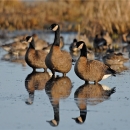About Us
Located near the confluence of the Santiam and Willamette Rivers, just off of Interstate 5, Ankeny offers unique wildlife viewing opportunities for the whole family! The refuge offers convenient access to miles of boardwalk and dirt trails as well as handicap and stroller accessible viewing platforms for its human visitors. Refuge kiosks and trails provide an interpretive and informative experience for visitors, so make sure to stop at the interpretive signs along the way to learn more about the refuge habitats and how they are maintained for wildlife.
Habitat Types
Seasonal Wetland
The majority of Ankeny NWR's wetland habitat is seasonal. These are wetlands flooded by precipitation in the cool seasons and are then dried up by the summer heat. Most of the Refuge seasonal wetlands, however, are managed using a combination of dikes, spillways and water control structures. Using the water control structures, Refuge managers can release water collected and retained during the winter. This seasonality reflects the bird usage of the wetlands which numbers in the thousands during the winter, and drops down to mere hundreds in the spring and summer.
Permanent Wetland
42 of Ankeny's 530 wetland acres are permanent wetlands, with an additional 186 serving as permanent or seasonal depending on management decisions. These permanent wetland areas provide space for nesting waterfowl to raise their young, homes for red-legged frog and Oregon chub, and hunting grounds for osprey during the summer.
Wet Prairie
Wet prairies are characterized by shallow ponding of water on the prairie floor up to 6" deep throughout the winter and early spring. They are known for their mounded topography which forms low points that flood seasonally and create a unique environment to support a broad diversity of plant species. Once the most widespread habitat type on the Willamette Valley floor, intact historic wet prairie land today numbers less than 1% of its original area. Due to the rarity of this habitat type, many plant species native to the wet prairie are declining and listed as endangered or threatened under the Endangered Species Act.
Riparian
Riparian areas are vital habitat corridors for a number of different species of wildlife. Riparian hardwood forests once dominated the floodplains of the Willamette River; at the arrival of Euroamerican settlers these forests made up about 10% of vegetative cover in the Valley. Since the 1850's, these bottomland riparian riparian
Definition of riparian habitat or riparian areas.
Learn more about riparian forests have declined by over 70%. To explore the riparian woodlands of Ankeny NWR, take a walk down the Rail Trail Boardwalk.
Agricultural Fields
Representing the largest swath of land on the refuge, the agricultural crops grown on the refuge land provide essential fodder for wintering Canada geese. A vast majority of these agricultural fields are managed cooperatively with local farmers, thus benefiting both the refuge management goals as well as the farmers.
Our Mission
The mission of the National Wildlife Refuge System is to administer a national network of lands and waters for the conservation, management and, where appropriate, restoration of the fish, wildlife and plant resources and their habitats within the United States for the benefit of present and future generations of Americans.
Every national wildlife refuge national wildlife refuge
A national wildlife refuge is typically a contiguous area of land and water managed by the U.S. Fish and Wildlife Service for the conservation and, where appropriate, restoration of fish, wildlife and plant resources and their habitats for the benefit of present and future generations of Americans.
Learn more about national wildlife refuge was created for a special purpose. Some were created to protect migratory birds, others to protect threatened or endangered species or unique habitats, while others fulfill another special purpose. All activities allowed on refuges must be evaluated to make sure each activity will not conflict with the reason the refuge was founded.
Our History
The area was previously known as "Ankeny Bottoms" and was selected as a refuge site to provide overwintering habitat for the dusky Canada goose and other migratory waterfowl. The dusky Canada goose is a subspecies of Canada goose that was in a decline in the late 1950's and early 1960's. This was primarily due to earthquakes and floods in its nesting habitat on Alaska's Copper River Delta, and the urbanization of its wintering habitat in the Willamette Valley.
Today, the refuge’s extensive croplands are managed to provide winter forage for the geese, which reduces depredation of surrounding private fields and promotes a healthy wildlife-landowner relationship as well as providing for the geese. The refuge also provides wetlands and riparian riparian
Definition of riparian habitat or riparian areas.
Learn more about riparian woodland sanctuary for migratory and resident wildlife which range from the tiny Pacific chorus frog to the black-tailed deer.
Other Facilities in this Complex
Ankeny National Wildlife Refuge is managed as part of the Willamette Valley National Wildlife Refuge Complex. A National Wildlife Refuge Complex is an administrative grouping of two or more refuges, wildlife management areas or other refuge conservation areas that are primarily managed from a central location. Refuges are grouped because they occur in a similar ecological region and have a related purpose and management needs. These refuges for example, were created in the 1960s specifically for the habitat they provide for the dusky Canada geese in the winter.
The Willamette Valley National Wildlife Refuge Complex consists of three refuges: William L. Finley NWR and its additional Snag Boat Bend Unit, Ankeny NWR and Baskett Slough NWR.

